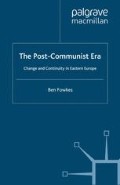Abstract
Any discussion of the process of transition in the post-communist lands is bound to raise problems of definition. The concept of the ‘post-communist lands’ is in itself not particularly problematic. No one doubts that over a large geographical area covering the eastern part of Continental Europe and the northern part of Asia the communist experiment came to an end at the turn of the 1980s (though there is still room for discussion about the political and economic persistence of communist structures over much of the former Soviet Union, particularly Central Asia). But problems arise with any attempt to subdivide the area. The term ‘Eastern Europe’ has traditionally been used for the western part of the communist world. It would be very convenient if we could divide the area neatly in two, defining ‘Eastern Europe’ as the part which came under indirect Soviet rule after 1945, as opposed to ‘the former Soviet Union’, which was directly ruled from Moscow.1
Access this chapter
Tax calculation will be finalised at checkout
Purchases are for personal use only
Preview
Unable to display preview. Download preview PDF.
Notes
E. Hankiss, East European Alternatives (Oxford: Oxford University Press, 1990).
P.G. Lewis, Central Europe since 1945 (London: Longman, 1994).
J. Rothschild, Return to Diversity: a Political History of East-Central Europe since World War II, 2nd edn (Oxford: Oxford University Press, 1993).
B. Fowkes, The Rise and Fall of Communism in Eastern Europe, 2nd edn (London: Macmillan, 1995).
C. Offe, Varieties of Transition: the East European and East German Experience (Cambridge: Polity Press, 1996), p. 151.
J. Snyder, ‘Introduction’, in B.R. Rubin and J. Snyder (eds), Post-Soviet Political Order: Conflict and State Building (London: Routledge, 1998), p. 2.
K. Jowitt, New World Disorder: the Leninist Extinction (Berkeley: University of California Press, 1992).
B. Milanovic, ‘A Cost of Transition’, Transition (WB) 5, 8, October 1994, pp. 1–4 (1).
Author information
Authors and Affiliations
Copyright information
© 1999 Ben Fowkes
About this chapter
Cite this chapter
Fowkes, B. (1999). Introduction: Mapping Out the Theme. In: The Post-Communist Era. Palgrave Macmillan, London. https://doi.org/10.1057/9780230376915_1
Download citation
DOI: https://doi.org/10.1057/9780230376915_1
Publisher Name: Palgrave Macmillan, London
Print ISBN: 978-1-349-40145-1
Online ISBN: 978-0-230-37691-5
eBook Packages: Palgrave Political & Intern. Studies CollectionPolitical Science and International Studies (R0)

